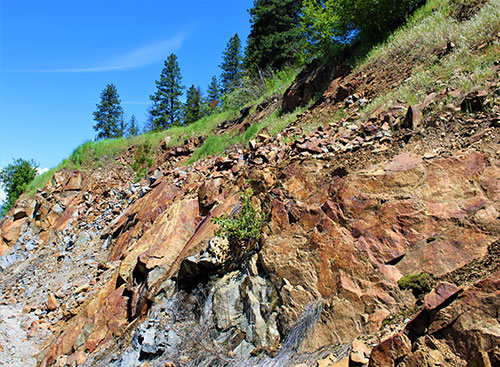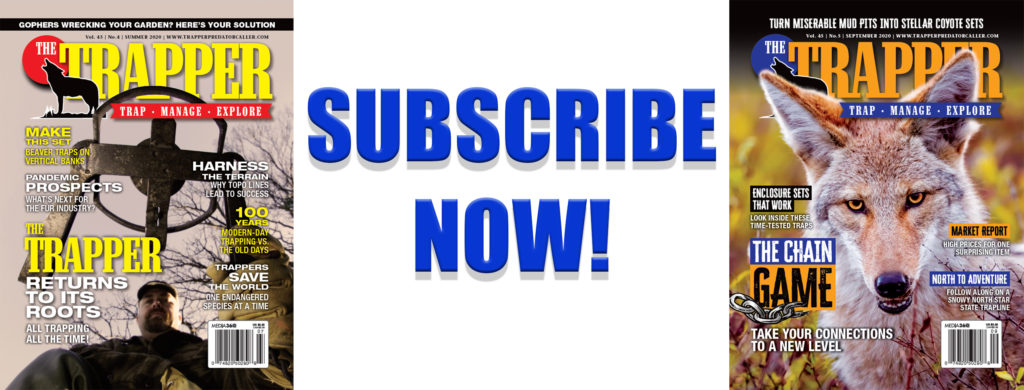By Toby L. Walrath
The soil on my small farm in northwest Montana offers up plenty of rocks. Every time I try to drive a fencepost or plant a tree I have to fight with rocks that can be anywhere from 1 inch to 20 inches in diameter. They don’t get much bigger than that around here despite the 6,000 foot peaks that surround my little valley. There’s plenty of soil here, and I can generally drive an earth anchor or stake anywhere I want to, although I might need to adjust a few inches one way or another when I’m making a set. Hitting one of those 20 inchers sends a jarring wave from my elbow right through my teeth, and I’ve learned to tap a bit more softly on the end of my stake driver.

From soggy farm fields to mountaintops, soil conditions change dramatically on the author’s trapline. Different equipment is needed for every soil type. Photo credit Toby Walrath.
Rocky soil is a term that comes up a lot in trapping circles. I see it on social media and hear it at conventions and fur sales, too. Over the past 15 years or so I’ve written about many challenges and solutions that we trappers face and a lot of the discussion revolves around soil conditions. It would sure be nice to define rocky soils. I’m not naïve enough to think that can be done in one fell swoop, but I do think there needs to be some perspective brought to the conversation so that the next time you’re standing at the table of a vendor at a state or national convention, you can speak the same language. So to begin, I’ll ask a really basic question, one that might seem easy to answer: Just what exactly is rocky soil?
The mountains in my area shoot straight up from the valley floor, forming cliffs that can be several hundred or even thousands of feet high. When those cliffs weather and break off, huge rocks the size of my pickup truck can tumble down, smashing and breaking up into smaller chunks that are nearly impossible to walk over, let alone drive an earth anchor into. The result isn’t rocky soil, it’s more like rocks with a little dirt scattered on top. The bottom edge of the mountains are heavily timbered and the moss-covered rocks that divide the cliff tops from the timber bottoms are often covered in really thin soil. These areas can be excellent travelways for predators, but it’s impossible to stake a trap in that stuff. Instead, I’ve had to adapt with drags. There may as well be a sign up that reads: “Stakes aren’t welcome here.”
Moving away from the rocky cliffs, the ground becomes covered with soil — albeit sparsely in some areas. There are places in Montana where the top 20 feet of soil is essentially free of rocks. Geologists claim that those trappers lucky enough to drive stakes into the ground in those areas are enjoying the work of melted glaciers that flowed through the region a few thousand years ago. It’s basically sediment from ancient rivers.
That’s the type of soil that can spoil you. And that’s the type of soil that many trappers across the country think about when discussing the merits and shortcomings of earth anchors and rebar stakes. Sometimes I’ll explain situations when I couldn’t get either one to pound down, or had to leave a dozen stakes in the ground because even my stake puller couldn’t get them out on moving day, and I get strange looks from the listeners. I’ve had trappers tell me about the equipment they use that works well for them, and when I say that I’ve tried it and get about three swings in before things get bent, twisted and busted, they become convinced that I’m doing something wrong.

A cross section of rocky soil exposed on the author’s trapline shows the obstacles for stakes that can be found below the surface. Photo credit Toby Walrath.
Experienced trappers from parts of the country like this often scratch their heads and wonder what I’m talking about when the conversation turns to stakes and rocky soil. I’ve reviewed advice from well-meaning trappers about dealing with rocky soil, only to find out that our definitions of rocky are very different. It’s like discussing deep-snow trapping with someone who gets a dozen or so days of snow each year with temps hovering around the 32-degree mark. When I explain that in my region our annual snowfall can exceed 100 inches, and shows up sometime in late October and hangs on until sometime in May or even June, we realize that our definitions of snowy conditions aren’t aligned. What’s more, here in Montana, trapping season runs right through the winter. We’re often just getting started in early December for bobcats and wolves and the frozen ground adds challenges from day one.
Differences in perspective doesn’t mean that we can’t help one another troubleshoot challenges (which is the whole point of such discussions and articles like those found in this magazine), but we should get those perspectives sorted out first. It is also safe to say that most trappers around the country deal with more than one soil type every day. On any given day I could be on a wheat farm in clay soil in the morning and then several miles deep setting and checking traps along a Forest Service road surrounded by boulders and rocks in the afternoon. I’m not alone in this regard. I know plenty of trappers with a similar routine — no matter if they are in Idaho, Montana or New York.
That’s a good thing because for most of us, we can at least recognize that our equipment needs vary from one soil type to the next. This leads us back to answering the question that causes confusion between trappers when someone says they’re looking for advice to improve their equipment for rocky soil.
There isn’t a one-size-fits-all stake or anchor that works for every situation, at least not without some modification.

Depending on the set location in this terrain, it may or may not be possible to drive in a stake anywhere nearby. Photo credit Toby Walrath.
Years ago I learned a trick from a man named Gary Jepson, whose name I’ll bet most of you recognize. Mr. Jepson is an exceptional trapper who produced some excellent trapping videos years ago after several decades of trapping. The trick that I learned was simple. When dealing with soft, sandy soil, or “fickle soil,” as he put it, drive a rebar stake about halfway and then push it sideways to give it a slight curve, before pounding it the rest of the way in. That one simple trick opened up a whole lot of new set locations for me and I virtually stopped double-staking once I learned how to make the equipment I already had function better. Now it’s just part of my normal routine.
The same holds true for rocky ground. When I say that the ground is rocky it generally means that it’s soil that won’t allow me to drive a stake wherever I want. In rocky conditions, I often select my set locations after making several attempts to drive a stake. I choose the location based on where the soil allows me to stake. My first step in set construction used to be digging a trap bed, followed by stake-pounding, but I’ve learned that’s a waste of time. Many times I have to abandon a location altogether simply because I can’t anchor the trap. So now I drive first, dig second.
If a perfect set location is right where a stake just won’t drive or won’t drive deep enough to give me the confidence to make the set, I’ll use a drag. But, I try to limit the use of drags because of the time it takes to check them.
After years of dealing with searching for critters I now use really long drag chains — sometimes exceeding 15 feet. I’ll even go 20 feet or more on wolf sets. I also lean a 5-foot pole against a nearby tree or rock that is in the path of the drag so that I can tell from a distance if I’ve caught something. When the pole is down it signals a closer inspection is needed.

The author drives a stake into rocky soil first to make sure it’s possible, before digging trap beds. Photo credit Toby Walrath.
In locations where the bedrock is at ground level, it can be tough to bed a trap and conceal it. For bobcat sets it won’t take much more than a piece of roofing material on an exposed pan. But for canines, it takes a bit of strategic thinking. I’ll scratch out a bed deep enough to get a trap to sit 1/2 inch lower than the surrounding earth, and pack waxed sand in as hard as I can around the trap. Then I’ll add whatever is there for a light covering to blend it, and I’ll pack that hard, too. The only place allowed to have any loose dirt is above the pan. I think that most dig-ups in these scenarios come about because of the sudden presence of loose dirt. To a coyote or fox, loose dirt means that something happened there and the digging begins. Diligence in packing that dirt solidly around the trap is absolutely necessary to reduce digging problems. I will literally punch the ground around a trap to get the dirt compacted, because that’s what it takes.
The excess chain in rocky ground should be pulled straight out and on top of the ground, as concealed as possible. I bury the first few feet of chain beginning at the trap and let the rest of it wind through whatever ground cover is there. This works about as good as can be hoped for in regions with rimrock or where bedrock is just below the surface. Sometimes the ground is so rocky that you just can’t drive a stake in.
I used to teach trappers education with a friend of mine named Denny Schutz, who stood in front of a classroom one day and said something to the effect of, “There’s no need to carry around rebar stakes unless you’re a Neanderthal!” Few people can match Denny’s enthusiasm for trapping and his voice is so distinctive that I think I could recognize it anywhere, loud and rough — and I might add tough. After decades of trapping, Denny was sick of carrying all of that heavy rebar around and just loved the day when he traded all that weight for earth anchors. And I can’t blame him!
But, when pounding earth anchors into rocks the earth anchors get beat up. I’m constantly grinding burrs off of stake drivers after they get stuck in the anchor. Often, with flat anchors, the edges of the driver become so damaged that there’s no way to even get the anchor onto the driver. Sometimes it only takes a stake or two to ruin my driver. To combat this, I’ll carry several drivers, but by midday I often find myself with a flat file trying to get a driver back into usable condition. Or, I just reach for those old rebar stakes and get to work. They’ll either drive or they won’t — there’s no middle ground like pulling a driver and having the stake come back out with it, stuck on the end of my driver.
For the trappers wondering why you don’t have these issues with rocks, well not all rocks are created equal. Granite and quartz are far different from limestone and sandstone. They were formed when hot magma bubbled up and slowly cooled into the driver-chewing beast that has caused me so much grief over the years. Geologists and high-school science teachers call these igneous rocks.
Meanwhile, some of my Midwestern friends, those who often can’t relate to my frustrations, deal with rocks that formed by years of sediment building up in wet areas that eventually hardened to achieve rock status. These are called sedimentary rock. They are still rocks, but are nowhere near as hard as granite. To add a little more complexity, there are rocks that originally formed as igneous rock or sedimentary rock, that through high heat, pressure and mineral-rich fluids all mashed together, formed a mix of both. These are metamorphic rocks.

There are many equipment options available to trappers, but there is no one-size-fits-all solution for every soil condition. Photo credit Toby Walrath.
Now, this isn’t a scientific research paper and I know there are people out there who can go on about the complexities of rocks for days. But I’m not a geologist — I’m a trapper who deals with rocks enough to understand that some rocks cause problems while other rocks don’t.
There lies the answer to the question about what rocky soil is for trappers: Rocky soil is the presence of enough rocks in the ground to cause difficulty driving and pulling stakes. Depending on where you are in the world, the equipment you need varies right along with the rocks found there.
Hopefully, the next time you’re problem-solving with trappers from various parts of the country and the topic changes to rocky ground, the conversation can start with the type of rock and how it affects your equipment — instead of the offering of advice — which most trappers are already good at.

